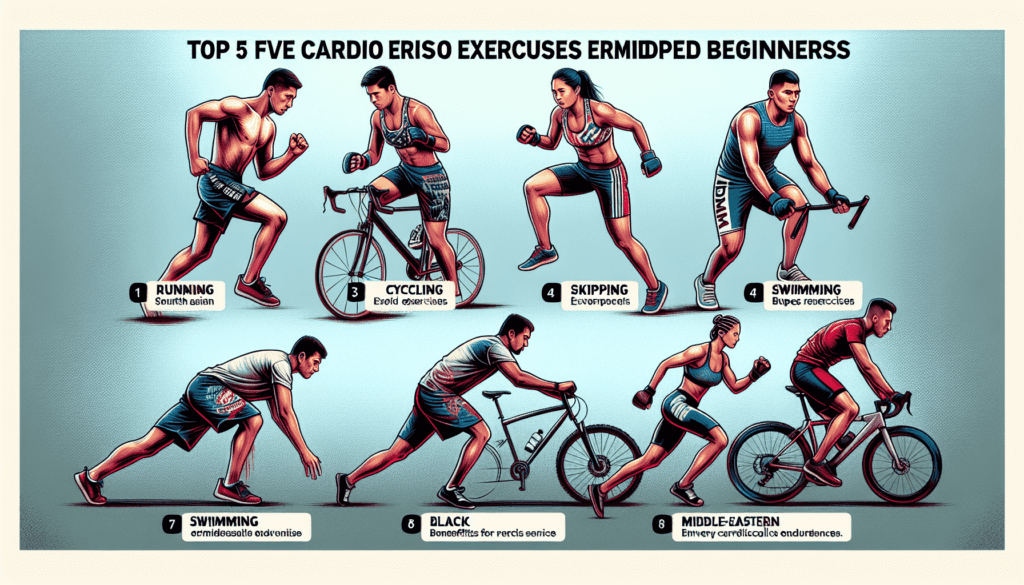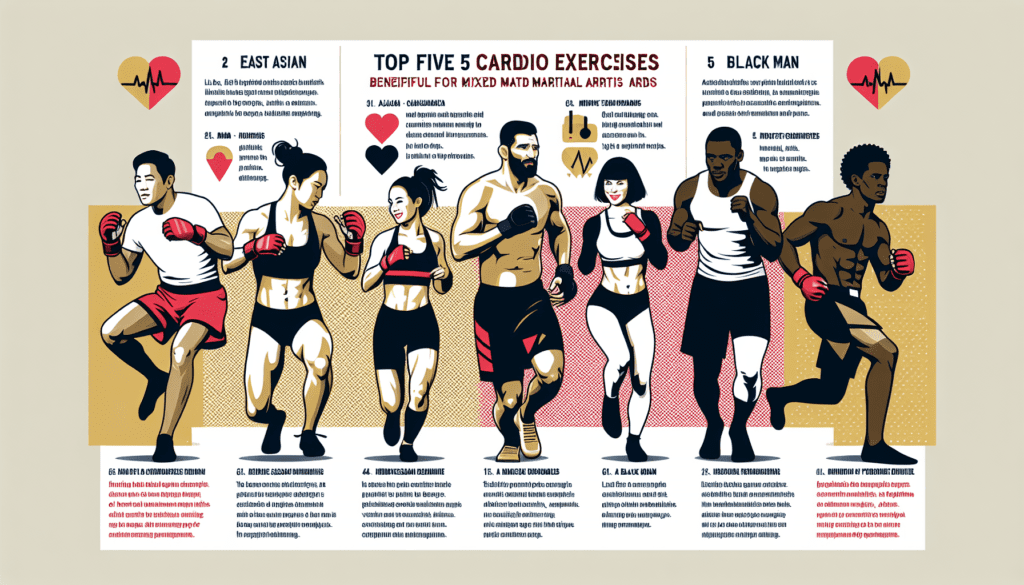If you’re a beginner in the world of Mixed Martial Arts (MMA) and looking to improve your cardio, we’ve got you covered. Enhancing your cardiovascular endurance is crucial for success in the ring, and in this article, we’ll explore the top five cardio exercises tailored specifically for MMA beginners. From high-intensity interval training to circuit workouts, you’ll discover effective and engaging ways to boost your stamina and take your MMA training to new heights. Whether you’re preparing for your first fight or simply want to improve your overall fitness level, these exercises will help you build strength, endurance, and the mental toughness required to excel in the world of MMA. So lace up your gloves, get ready to sweat, and let’s dive into the top five cardio exercises for MMA beginners!
Jumping Rope
Benefits of Jumping Rope
Jumping rope is a fantastic cardio exercise that offers numerous benefits. First and foremost, it is an excellent way to improve cardiovascular fitness. Jumping rope gets your heart rate up and increases your lung capacity, which enhances your overall endurance. This is crucial for MMA fighters, as fights can be physically demanding and require sustained energy. Additionally, jumping rope helps in developing coordination, agility, and balance, as it requires precise footwork and timing. It also strengthens your lower body, including your calves, quads, and hamstrings, while engaging your core for stability. Overall, incorporating jumping rope into your training routine can greatly enhance your performance in the MMA arena.
How to Jump Rope
Jumping rope may seem simple, but proper technique is essential for maximizing the benefits and preventing injury. Here’s how to jump rope effectively:
- Start by selecting the right rope length. Stand on the middle of the rope and ensure that the handles reach your armpits.
- Hold the handles firmly, with your hands positioned slightly in front of your hips.
- Stand with your feet together, knees slightly bent, and elbows close to your sides.
- Begin rotating the rope by flicking your wrists and jumping over the rope as it comes around. Keep your jumps small and land lightly on the balls of your feet.
- Maintain a relaxed posture, engaging your core muscles for stability.
- Start with a comfortable pace and gradually increase your speed as you become more proficient. Remember to start slowly and gradually increase the intensity and duration of your jumping rope sessions as your fitness level improves.

Tips for Jumping Rope
To get the most out of your jumping rope workouts, consider these helpful tips:
- Wear supportive and cushioned footwear to protect your feet and ankles.
- Start with shorter sessions and gradually increase the time as your stamina improves.
- Incorporate different jumping styles and variations, such as single jumps, double unders, or criss-crosses, to challenge yourself and avoid boredom.
- Keep your jumps smooth and rhythmic, avoiding excessive arm or leg movement.
- Incorporate jumping rope into a well-rounded workout routine that includes strength training and flexibility exercises.
- Stay consistent with your jump rope practice to see long-term improvements in your cardio fitness and overall performance.
Running
Benefits of Running
Running is a timeless and effective form of cardiovascular exercise. It offers numerous benefits that are particularly advantageous for MMA fighters. Firstly, running is a fantastic way to build endurance, as it engages major muscle groups while simultaneously increasing your heart rate. Regular running sessions can improve your cardiovascular fitness, allowing you to fight longer and with more intensity. Moreover, running helps to burn calories and maintain a healthy body weight, which is crucial for efficient movement inside the octagon. It also strengthens your legs, including your quadriceps, hamstrings, and calves, which are essential for powerful kicks and explosive movements.

How to Start Running
Running is an accessible form of exercise that requires minimal equipment. Here are some steps to get started:
- Invest in a good pair of running shoes that provide proper support and cushioning for your feet.
- Begin with a warm-up, which includes dynamic stretches and light jogging to prepare your muscles for the activity.
- Start with a brisk walk or a slow jog to gradually warm up your body and familiarize yourself with the motion.
- Gradually increase your running duration and distance over time, allowing your body to adapt to the demands.
- Listen to your body and take rest days as needed to prevent overuse injuries.
- Consider incorporating interval training, which involves alternating between running and walking or sprinting and jogging, to challenge yourself and improve cardiovascular fitness.
Running Tips
To make the most of your running routine, keep these tips in mind:
- Prioritize proper form by running with an upright posture, relaxed shoulders, and a slight forward lean.
- Breathe deeply and rhythmically to optimize oxygen intake and reduce fatigue.
- Vary your running terrain, incorporating inclines, hills, and trails, to engage different muscles and challenge your body.
- Gradually increase your running intensity by incorporating speed intervals, hill sprints, or tempo runs.
- Stay hydrated before, during, and after your runs to maintain optimal performance.
- Wearing moisture-wicking clothing and protective sunscreen can enhance your comfort and protect your skin during outdoor runs.
Cycling
Benefits of Cycling
Cycling is a low-impact cardiovascular exercise that offers a wide range of benefits for MMA fighters. One of the major advantages of cycling is its ability to improve cardiovascular endurance. Regular cycling sessions help to strengthen your heart and lungs, increasing their efficiency in delivering oxygen to your muscles during fights. Cycling also helps to build leg strength and power, enhancing your ability to execute powerful strikes and explosive movements. Additionally, it is a joint-friendly exercise, making it a great option for fighters with existing joint issues or those looking for a non-weight bearing cardio alternative.
How to Start Cycling
Getting started with cycling is relatively straightforward. Follow these steps to embark on your cycling journey:
- Obtain a suitable bicycle that aligns with your fitness goals and preferences. Choose between road bikes, mountain bikes, or stationary exercise bikes.
- Make sure your bicycle is properly adjusted to your height and comfortably fits you. Consider seeking professional guidance if necessary.
- Begin with shorter cycling sessions on flat terrain to build your fitness foundation and get accustomed to the bike.
- Gradually increase your distance and intensity over time, tackling longer rides or incorporating intervals and hill climbs as you progress.
- Familiarize yourself with cycling etiquette and safety rules, including how to signal, ride in traffic, and navigate intersections.
- Explore different cycling routes and environments to keep your workouts engaging and enjoyable.
Cycling Tips
To optimize your cycling workouts, consider the following tips:
- Always wear a helmet and other protective gear to ensure your safety while cycling.
- Invest in padded cycling shorts and comfortable cycling shoes to enhance your comfort during longer rides.
- Pay attention to your cycling cadence, aiming for a consistent rhythm that allows you to maintain good form and sustain your energy.
- Regularly maintain and inspect your bicycle to ensure it is in good working condition, including properly inflated tires, well-lubricated chains, and functioning brakes.
- Consider incorporating interval training or hill repeats to improve your cycling performance and mimic the intensity of MMA fights.
- Remember to listen to your body and take rest days as needed to prevent overuse injuries and promote recovery.
Rowing
Benefits of Rowing
Rowing is a full-body exercise that offers several benefits for MMA fighters. One significant advantage is its ability to improve cardiovascular endurance. Rowing engages large muscle groups in both the upper and lower body, making it an efficient way to increase your heart rate and enhance overall stamina. It is also a low-impact exercise, minimizing stress on your joints while still providing an intense workout. Rowing helps to build strength and power, particularly in your legs, back, and core muscles, which are crucial for generating force and maintaining stability during fights. Furthermore, rowing promotes proper posture and body alignment, which can prevent injuries and improve overall movement efficiency.
How to Start Rowing
If you’re new to rowing, follow these steps to get started:
- Familiarize yourself with the different types of rowing machines available, such as water rowers or air rowers, and choose the one that suits your preferences.
- Adjust the footrests and seat position on the rowing machine to ensure a comfortable and proper rowing motion.
- Begin with a warm-up, which may include some light rowing or dynamic stretches to prepare your muscles for the activity.
- Focus on mastering the proper rowing technique. Sit on the seat, grab the handle with an overhand grip, and push with your legs, then lean back and pull the handle towards your chest while engaging your core and maintaining good posture.
- Start with shorter rowing sessions and gradually increase the duration and intensity as your fitness improves.
- Experiment with different rowing tempos and stroke rates to challenge yourself and keep your workouts diverse.
Rowing Tips
To make the most of your rowing sessions, consider these tips:
- Prioritize proper form and technique to avoid unnecessary strain on your back and shoulders. Focus on maintaining a smooth and fluid motion throughout the entire rowing stroke.
- Keep your core muscles engaged throughout the rowing movement to maintain stability and power transfer.
- Vary your rowing workouts by incorporating longer, steady-state rows, as well as high-intensity interval training (HIIT) sessions.
- Consistency is key. Aim for regular rowing sessions to build endurance and improve overall cardiovascular fitness.
- Keep your rowing workouts interesting by listening to music, podcasts, or audiobooks, or by incorporating rowing challenges or competitions with friends or training partners.
- Don’t forget to stretch and cool down after each rowing session to promote muscle recovery and prevent stiffness.

